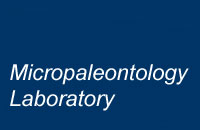


The Micropaleontology Lab, under the direction of Professor Mark Leckie, is a hub of activity by both graduate and undergraduate students. The "Micropaleo Lab" features a sample prep area and research space for 5-6 students. We house an extensive micropaleontology research library that has grown substantially over the years thanks to donations from Chevron and the late Dr. Bruce Masters, formerly of the Amoco Research Lab in Tulsa. Research by Leckieand his students focuses primarily on planktic and benthic foraminifera of Cretaceous and Cenozoic ages. In addition to providing important baseline information about population dynamics, biotic response to global change, water column structure, depositional environment, evolution, and relative age (biostratigraphy), foraminifera also serve as important tools in paleoceanographic research because their carbonate shells can be analyzed for stable isotopes of oxygen and carbon. Isotopic data provide valuable estimates of sea surface temperatures, water column structure, and productivity. Whenever possible (often determined by preservation of foraminiferal carbonate) we employ a two-fold research strategy that yields complementary and independent proxies of upper water column structure and productivity; namely, population analyses and isotope paleoecology (e.g., Nathan and Leckie, 2009). Much of our stable isotope work is done in-house in the Stable Isotope Laboratory under the direction of Professor Steven Burns. Current projects include Miocene paleoceanography and sea level history based on Ocean Drilling Program (ODP) sites from the western tropical Pacific, northeast Australian margin, and South China Sea. The micropaleo research group has sailed with a number of ODP legs in the region: Leg 130 (Ontong Java Plateau), Leg 184 (South China Sea), Leg 194 (Marion Plateau), and Leg 198 (Shatsky Rise). Other deep-sea paleoceanographic research focuses on mid-Cretaceous Oceanic Anoxic Events and late Campanian-Maastrichtian paleoceanography. One aspect of our mid-Cretaceous research is to test the relationship between planktic foram evolution and tectonic activity, specifically the influence of submarine hydrothermal activity on productivity and carbonate chemistry. We are also actively involved in paleoceanographic and sequence stratigraphic research in the U.S. western interior where a vast epicontinental sea covered the region during Late Cretaceous time. We have past and current field-based research projects in Colorado, Utah, Arizona, and Montana, in rocks spanning the upper Cenomanian to lower Campanian.
Data-model comparisons are an exciting component of our Miocene and Cretaceous paleoceanographic research at UMass. Professor Rob DeConto provides complementary expertise in paleoceanography, paleoclimatology, and climate modeling. Collaborative research and/or teaching provides additional links between paleoceanography and multiple facets of low temperature geochemistry (Steve Burns and Richard Yuretich), biogeochemistry (Steve Petsch), glacial geology (Julie Brigham-Grette), and paleoclimatology (Ray Bradley). |
This site is maintained by the Department of Geosciences
